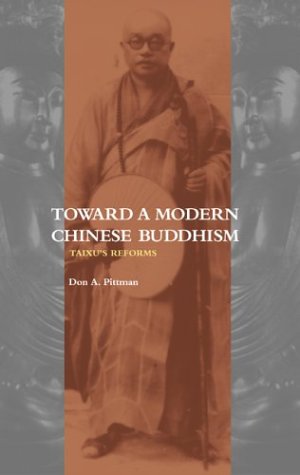Historically, Buddhism has disappeared from most communist countries, but not China or Vietmnam. Chinese Buddhism did change, due to the encounter with other religions, and with the Western world. My main argument here is that revival is not a useful term to describe modern Chinese Buddhism because it creates misconceptions about such developments that occured between 1850 and 1950.
Religious and Historical background of Chinese Buddhism
Buddhism under Threat
Chinese Buddhism is an amalgamation of traditional Buddhist belief and Taoism. Within the traditional system, the monastery is the centre of Buddhist activities. Chinese Buddhism often includes praying to Boddhisattvas and prayer with incense.
Chinese Buddhism is divided into two catergories. Firstly, gradualism, which views enlightenment as a process. Secondly, Subitism, which believes in Buddha nature, thus enloghtenment now. Subitism was adopted by all schools by the 9th Century.[1]
Between the 7th Century and the 13th Century, indigenous schools of Chinese Buddhism formed, which used enlightenment in a more subitist way than Indian predecessors. By the 13th Century the three main schools were Chan (Zen), Jado (Pureland) and Tiantai (Tendai). [1]
The Ming Dynasty (1368 – 1644) was an ethnically Chinese Dynastic period. Buddhism was in tight connection with the state and was supported by aristocracy. The Qing Dynasty (1644 – 1912) was Manchurian, but ruled as Chinese. It was a multi-ethnic, multi-lingual and multi-religious empire that illicited the support of Buddhist authorities in Tibet and Mongolia.[1]
However, from 1850 onwards the situation changed dramatically. China went through the traumas of wars and semi-colonisation. The Taiping rebellion occurred in 1851-1865, a rebellion movement that shattered Qing powers on the area of Jiangnan. Taiping claimed to be the brother of Jesus, drawing parrallels between their lives. People became truly modern in their attitudues.[1]
The Chinese Buddhist Revival
So, Buddhism had become under threat from 1850 onwards, and was in need of a ‘revival’. There were four main areas areas of revival at this time. Firstly, there was a revival of publishing houses and a wider circulation of Buddhist material. Secondly, schools were set up to provide better education for monks. Thirdly, the lay Buddhists ran clubs, primarily for social and charitable reasons, but partly to hold sermons. Fourthly, ecumenical contact with monks abroad – at the same time, monks were simultaneously trying to unite the Buddhists of China.[1]
Yan Wenhui (1837-1911)
Yan Wenhui was the first to go on to Europe and to think of Buddhism as a ‘world’ religion. He produced volumes of the Tripitaka (Buddhist Canon) and started the Chin Ling Press. He went to London in 1878 and returned again in 1886 to study industry, poilitics and English. When the government wouldn’t take his advice, he quit working for the embassy and devoted his life to Buddhism. In 1890 he asked a kinsman of his wife to take with him to Japan a request to Narjo for Buddhist scriptures. The kinsman returned with a few hundred volumes and Yang printed the best.[1]
Dharmapala was a Buddhist monk who felt strongly that Buddhist holy places in India should be protected. Dharmapala made the appeal for this to Lung Hua Ssu in Shanghai. They accepted, but rejected the very next day, probably because Dharmapala approached them from a religious society. Timothy Richards (Rev.) introduced Yang Wenhui to Dharmapala. Yang agreed that there was a need to protect Indian holy places, but said that the Indians should come to China instead.[1]
Over the next few years, Yang was influenced by three particular events. In 1896 the Japanese Higashi-Honganji set up a branch in Nanjing to serve the Japanese Buddhists and attract converts. In 1898 was the ‘hundred days’ of political reform in which Yang was closely involved. In 1905 the civil service examination system gave way to the programme of modern schools. This led to the creation of Jetevana hermatage being set up in Yangs mansion. It was a school to train missionaries for travel abroad. Yang was the first layman to actually teach Buddhism. His emphasis was on the Dharmalaksana school which he taught to be compatible with science. The school, however, closed after one year due to lack of funding. Yang Wenhui dies at the age of 75 in 1911.[1]
Tai Hsu (1889-1947)
Tai Hsu’s main idea was that Chinese Buddhism offers tools to acclimatise to modernity, and it was as universal as Christianity. Tai Hsu used advertisements and was a good public speaker – qualities that you would not necessarily expect to find in a Chinese Buddhist monk. His methodology was based upon the compatibility of religion and science. He was concerned about the activity going on outside of the monastery such as medical facilities and orphanages.[2]
The invasion of the Chin San monastery led Tai Hsu and his followers to invade central leadership. In 1915, Tai Hsu spent three years of confinement, which led to his reorganisation of the Sangha. In 1922 he opened a seminary. He also opened the Wutang college for Buddhist studies, which then led to these consequentially opening throughout the country.[2]
In 1923 he started a series of world Buddhist associations. In 1924 was the first conference of the world Buddhist federation. In 1928 Tai Hsu attained backing for his world tour and began his travels to the West, conducting his grand tour in the ’30’s. In the 1950’s Tai Hsu set up the world fellowship of Buddhists. He became famous abroad, and also became the ‘bread and butter’ of Taiwanese Buddhism.[2]
Amazon Price: $103.01 Buy Now
(price as of Jun 19, 2016)
Chinese Buddhism – Was there a Revival?
After attaining these developments, it does appear that there was a Chinese Buddhism‘revival’, particularly in the 1920’s and 1930’s. However, I am going to demonstrate why it should not be labelled as a ‘revival’ at all. It was not labelled as a revival in the strict sense of the meaning of the word, as it was more restored to it’s original state.
There is no evidence of a doctrinal ferment, state support or popular tradition in the Tang Dynasty. There was no revival in Buddhists arts. Construction work was just to replace what was lost in the Taiping rebellion. The number of monks did increase, but that was merely due to political disorder.
Welch makes three points that are important here. Firstly, it was not a religious revival, but a redirection from the secular to the religious. Secondly, it was not a revival because it did not affect the population as a whole. The ‘occasional Buddhists’ who made up the majority of the leity and the ‘call monks’ who made up the majority of the Sangha were not involved. Thirdly, the ‘revival’ concealed trends which, had they continued, would have meant the eventual demise of Buddhism, not a growing validity for it. [1]
Conclusion
The term ‘revival’ is not useful in describing the developments in modern Chinese Buddhism because Buddhism was not completely restored to it’s original state. Therefore it gives a false impression of the developments in Chinese Buddhism. Welch only used the term ‘revival’ because it was the most convenient and customary way to refer to the developments. I would suggest that the terms ‘transformation’ or ‘redirection’ would be more useful in describing the events that lead to modern Chinese Buddhism.
If you are interested in Chinese Buddhism today, I recommend a visit to Emei Shan and all Leshan – the biggest Buddha in the World.
You might also be interested in finding out more about the temples of Myanmar and the best temples in Bali.
- Welch, Holmes The Buddhist Revival in China. Boston: Harvard University Press, 1968.
- Pittman, Don A. Toward a Modern Chinese Buddhism: Taixu’s Reforms. Honolulu: University of Hawaii Press, 2001.


1 thought on “Chinese Buddhism: Was there a Buddhist Revival?”